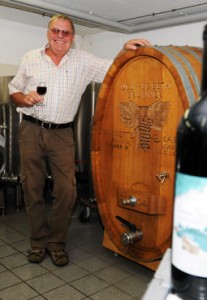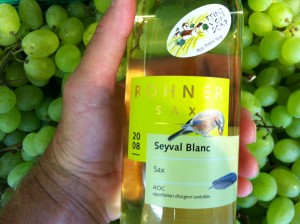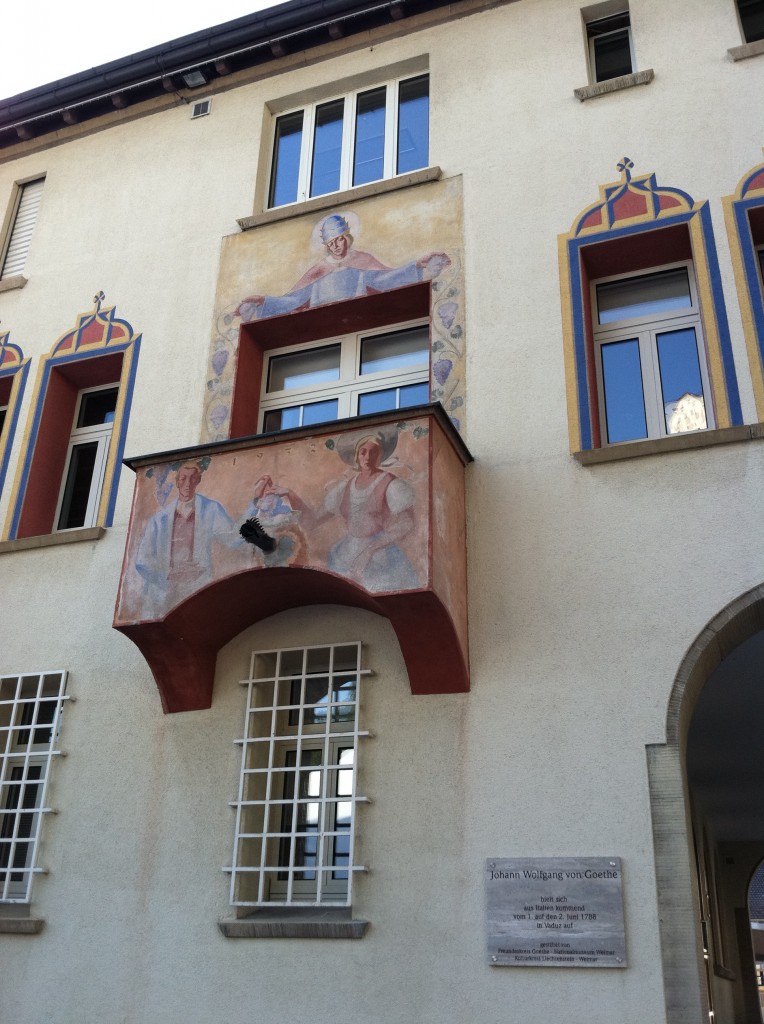
By Patrick Hunt
Converse with almost any native Swiss person about Swiss wine, and you should engage justifiable national or regional pride, since wine cultivation has been continuing since the Roman era, nearly 2000 years, especially in the Rhine Valley.
One of the loveliest Swiss wine districts is in the upper Rhine canton of St. Gallen, in the Werdenberg region of eastern Switzerland near the convergence of Austria and Liechtenstein. Last weekend (September 25, 2011) was the Winzerfest, the local Wine Festival in the village of upper Sax-Hueb, culminating with its grape harvest as well, and as the grape leaves have been turning festive yellow and red colors, plenty of local wine flowed. These vineyards may be among the most picturesque in Switzerland, as my photos can only suggest, with panoramas that stretch across the valley to Liechtenstein’s mountains, only a short, easy ride away across the Rhine River as I found by bicycle. Feldkirch in Vorarlberg, Austria is tucked away just over the hill to the east.

In late August while exploring old Roman roads in the region, I hiked along the Trübliweg southward between Frümsen and Sax, a road winding through the hills, through the Sennwald forest above the Rhine valley floor. The path curves along fragrant alpage grazing pastures all under the towering crags of the Kreuzberg range. Cowbells sound out intermittently along with more regular local village church bells. The Sax-Hueb hillside vineyards undulate with the topography because the Swiss tend to use their land so carefully and efficiently, making every square meter count, and few vistas are as satisfying to my eyes as vineyards along hills. While the vineyards are not the dominant landscape feature here, they are nonetheless carefully managed and treasured as a precious resource.

Just above the village of Sax, the road out of its hamlet of Hueb has one of the meticulous vineyards of Herr Brunner. Brunner has won silver medals in the International Weinprämierungen for his whites, especially his Pinot Blanc, and also for his red Blauburgunder, one of the German names for Pinot Noir. [1] Brunner wisely purchased south-facing hill property in 1981, planted vines two years later in 1983 and continued to expand until he now has 6,000 vines on 1.6 hectares (nearly 4 acres) and produces 10,000 bottles of wine. Nearby above the town of Sax are other vineyards and wineries as well, including the Rohner wine production.
Because the region can have good summer heat through early September, Brunner’s red wines in addition to his prize-winning Blauburgunder also include Cabernet Cubin, Diolinoir (a hybrid created in Switzerland in 1970 by crossing Rouge de Diolly and Pinot Noir) and Gamaret (a 1970 Swiss hybrid of Gamay and Reichensteiner). Brunner’s whites include Sauvignon Blanc, Chardonnay, his prize-winning Pinot Blanc and Riesling Sylvaner. Both Brunner’s and Rohner’s Sax wines should be valued far beyond the 14-21 euro prices. Brunner’s Diolinoir 2009 is one of the silkiest Swiss red wines I’ve ever tasted, bursting with flavor and character, not at all a lightweight wine but instead superb with a truffle risotto and cheese or just by itself. The bottle I tasted over several days is form his Hemberg vineyard.
Swiss enologists and botanists have hybridized quite a few hardy varietals for the Rhine region along with other Swiss climatic conditions overshadowed by the Alps, often with considerable rain and frost. André Jaquinet of the Station Fédérale de Recherches en Production Végétale at Changins is responsible for several of these new hybrids. The enology unit at Changins-Wädenswil is part of Agroscope, the Swiss Federal Research Office for Agriculture, and Jaquinet is following the footsteps of the famous enologist Dr. Hermann Müller-Thurgau (1850 – 1927), the first director of the Swiss unit at Wädenswil. Müller-Thurgau was a pioneer in wine cultivation after whom the worldwide varietal is named since he introduced it in 1882 by crossing Riesling and Madeleine Royal (not Sylvaner). Now over 41,000 hectares (over 100,000 acres) of Müller-Thurgau are cultivated worldwide in mostly cool climates as well as here in the upper Rhine valley.[2]

On a very warm August evening overlooking the Rhine Valley and Liechtenstein, we all indulged some of this Sax wine in Ueli and Lisel’s hillside garden in Sax-Hueb under the Kreuzberg, enjoying it with what may be the best quarktort in the world – certainly that evening – a regional dessert made by Lisel. The deliciously sweet quarktort was the perfect combination for balancing a local Sax white wine, Seyval Blanc 2008 (a hybrid often also named Seyve-Villard from some of its French origins, although also called Seibel). Summer warmth made this cooled local wine the most refreshing drink possible.


I also found to my delight that both Goethe and James Joyce appreciated this valley in their travels for varying reasons. Joyce came through this upper Rhine Valley multiple times and has a famous plaque in the nearby train station of Feldkirch, thankful his Ulysses was spared in 1915 [3]; likewise Goethe has a commemorative plaque in nearby Vaduz, Liechtenstein, from a layover visit in 1788. I do not know if Goethe or Joyce tasted local wines around here, but as they were both fond of good wine, I feel certain they would have enjoyed a foray here at least as much as I have. For anyone wanting to saturate the senses and the soul with beauty, I heartily recommend a summer Upper Rhine Valley cycling or hiking trip in the Werdenberg region along the Trübliweg (for winetasting, please call Herr Brunner first, see link: http://www.saxerwy.ch/kontakt.html). This wine visit would be my favorite culminating point, a bit of paradise. The Swiss surely know how to live well in this remarkably beautiful land. As Goethe said in his Wanderers Nachtlied, ‘Über allen Gipfeln ist Ruh,’ “Over all the mountaintops is peace.”


Notes:
[1] Jancis Robinson, ed. The Oxford Companion to Wine, Oxford, 1994, 117
[2] Tom Stevenson. The New Sotheby’s Wine Encyclopedia, 3rd. ed. Dorling Kindersley, 2001, 396. Also see Gesellschaft für Geschichte des Weines, 2011, “Hermann Muller-Thurgau”.
[3] a quote from 1932 when visiting his Feldkirch friend Eugene Jolas, while moving from Trieste to Zurich in 1915 during WWI, the Vorarlberg train was inspected by police and officials but Joyce avoided possible arrest and/or likely censorship of his manuscript.
